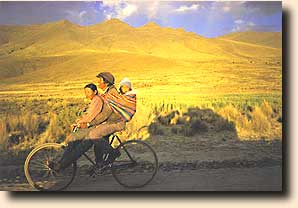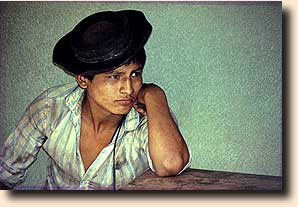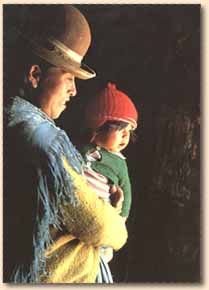|

Introducing my new slideshow now on
YouTube (in Danish, but enjoy the music):
"Children of the Incas
- with prince Joachim among Bolivia's Indians"
I started volunteer work for
CARE in 1991 - hesitant
and skeptical.
Ten years earlier I had traveled in Africa to look for
projects which American Pictures could support, but
became very critical of the way Denmark and other
countries administer aid.

Aid without racism?
With my experiences from the American racial scene I
saw a tremendous racism in the relationship between
donator and recipient. I was so depressed that I totally
gave up my enthusiasm for development assistance - one of
the reasons American Pictures closed down in Europe and
moved to America. I saw no alternative way at the
time.
Therefore I would only promise CARE to look at their
projects and only make a slide-show if I could whole-
heartedly support them. Well, I ended up being absolutely
carried away with their work. The racist relationship I
anticipated seemed completely absent - mainly because all
work was carried out by natives - not by highly paid
white foreigners surrounding themselves in a barbed wire
secured affluence and a corrupting negative life
style.
While such tends to increase the
psychological gaps in the world - leading to crime and
the killing of incentive - I now saw the opposite in
CARE: that their native employees - although of urban
origin - live with and learn from the peasants. This,
they say, helps to decrease their own psychological gap
to the peasants thus promoting initiative and mutual
feelings of dependency.
This is a brief and inadequate account of
articles I have written in the Danish media about my
reasons for working with CARE: "Development aid
and racism"

Working in Bolivia
In Bolivia I am engaged by CARE to follow the CADENA
project over a number of years. CADENA is financed by the
Danish government and works to improve the resource base
of 4,000 farm families in Chuquisaca through better
management of natural resources and rehabilitation of
degraded and eroded land. It includes community
organization and training in agro forestry and sustainable
agriculture, environmental education, rural credit, and
construction of irrigation systems and storage
facilities.
I made a slide-show about these efforts
which I tour with in Danish schools. A Spanish version
has been shown in Bolivia and an English version is being
made for
CARE USA. It has just been
updated as I in 1999 returned to Bolivia with CARE Denmark's patron prince Joachim and made
"Children
of the Incas - with prince Joachim among Bolivia¨s Indians."
Here
is the text
from the show.

Working in Nepal
In Nepal I am currently working on a similar show -
primarily about women in the Syangja Project. This aims
at promoting sustainable watershed management among 7,200
families through construction of drinking water,
irrigation and landslide control systems.
Also I have photographed CARE's work to preserve the
rain forest in Thailand and future plans include a show
about CARE's work in Vietnam.
CARE
DENMARK
CARE USA
|